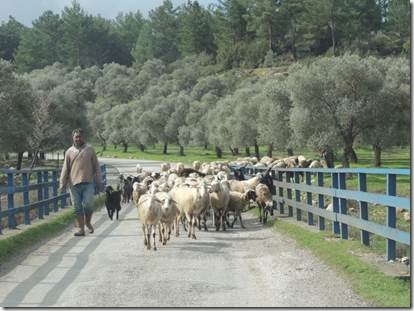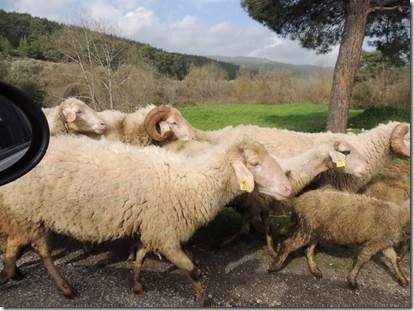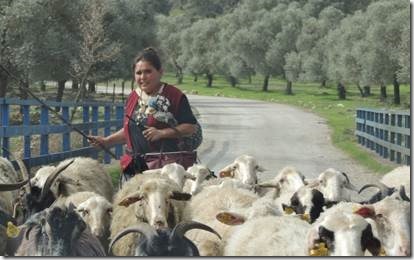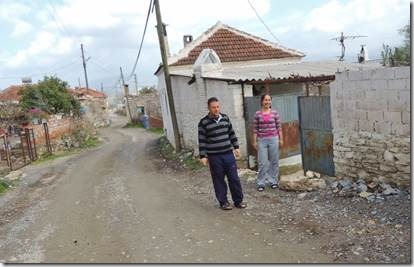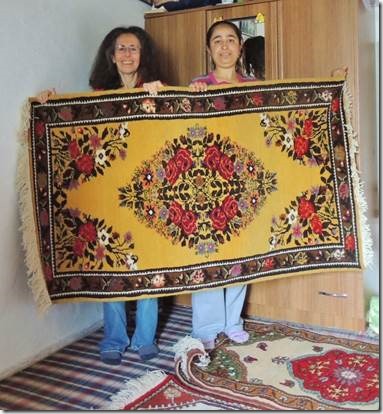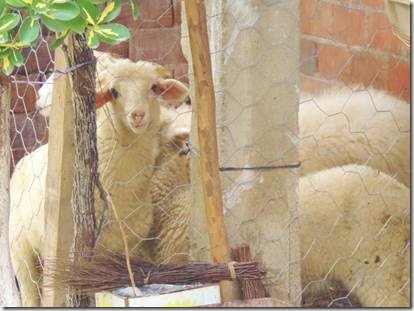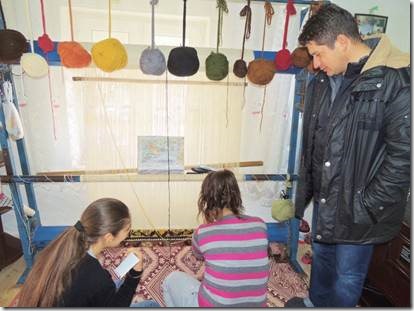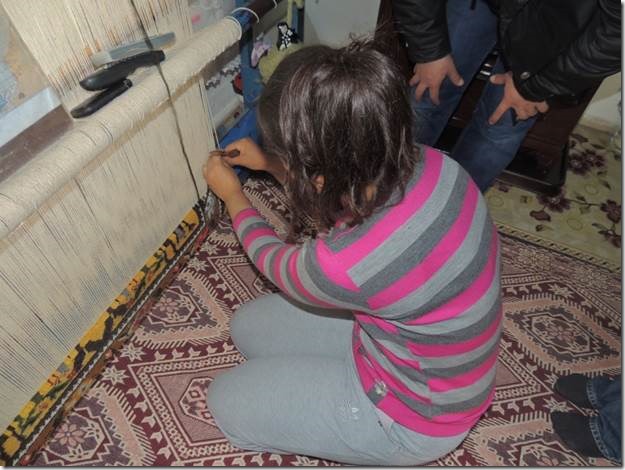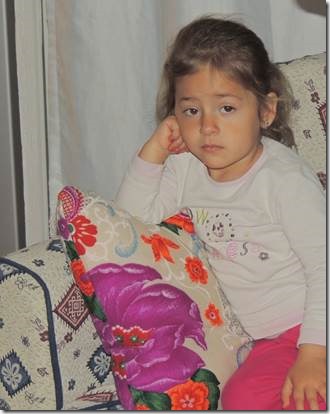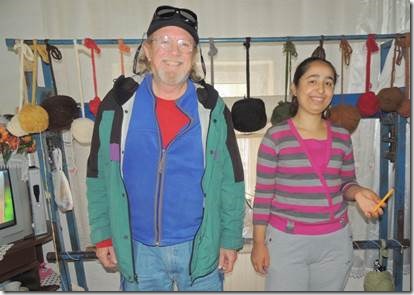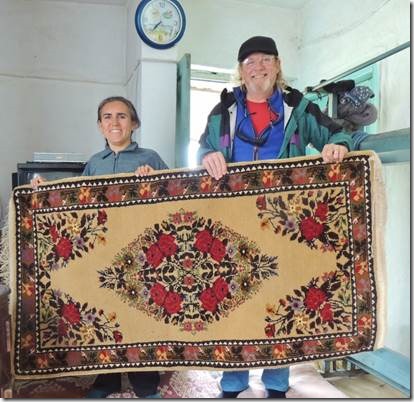Merhaba,
DoraMac is starting to look like a carpet showroom with rolled carpets stacked in the front cabin. But these aren’t showroom carpets. They are carpets from two women in the small village of Karacahisar. Here’s the story.
Ru
DoraMac
http://www.mydoramac.com/wordpress/?p=6794 is where this story all began in May of 2011 during our first visit to Turkey.
http://www.mydoramac.com/wordpress/?p=13462 is the second part which took place December 2012.
This is the final installment of our story about the “carpet ladies” of Karacahisar village.
Randal had a carpet made by one of the carpet ladies of Karacahisar. This past Sunday, our friends Deena and TK returned with us to collect the finished carpet.
|
Just as our previous visits to Karacahisar, we were stopped at the bridge by a herd of goats. We love this! |
|
There are about 3 streets in the village but we got lost finding Sebile’s house. |
|
While we were there we noticed a carpet that Sebile had woven and both Randal and I really liked it. We were particularly taken by the lovely golden color of the wool. |
|
This is a wool on wool carpet that will last past our life time. Randal and I loved the gold color which comes from a “corn flower” boiled for the dye. The browns come from walnuts. The red, green, and black are chemical dies. Some of the yarn came from Sebile’s sheep and some from her neighbors’ sheep. She spun, dyed, and then wove the wool into this carpet. Prior to the mid-19th century, many of the weaver’s color choices were dictated by the availability of certain plants in their region or what could be obtained by trade. Before the seminal year of 1860, when chemical dyes first arrived on the scene, plant based dyes were all that were available. These dyes are called vegetable dyes or natural dyes and have a distinct look about them. They age beautifully, work harmoniously together and the indigo dye, which creates all the ranges of blue, even preserves the wool. Usually with vegetable dyes one can observe a slight variation in the color itself. Also affecting this is the type of wool being used and how it was spun. Hand-spun wool, being less perfectly formed, will accept the colors of the dyes at different rates of the same shade and will show more variation in color than machine spun wool. Deeply saturated wool will also show less color variation which will only appear after the rug begins to age. This variation of color is termed "abrash" and adds a certain artistic quality and charm to tribal rugs which is often highly regarded. http://www.nhrugs.com/vegetable%20dyes.html |
|
The sheep! |
|
A similar carpet in progress with the pattern as a guide. |
|
Showing how it’s done; TK in particular was quite fascinated….maybe a retirement hobby. |
|
Sebile’s daughter kept her “poker face” our entire visit. Perhaps a future weaver; perhaps not. One day she took a scissor to her mom’s carpet in progress but thankfully it could be repaired. I was that kind of a kid only I took the scissor to my hair just before I was to have a set of photos taken. So only my sister has a set and not me. |
|
Randal never stopped smiling all day! |
|
When we left Sebile she gave a huge bottle of her homemade olive oil to Deena and me. Randal had made one of his famous walnut pies for the two carpet ladies Sebile and Gülümser to share. He gave both women a huge jar of corn syrup and the recipe for walnut pie translated into Turkish by Deena and TK. |
|
From Sebile’s house we drove the 2 minutes to Gülümser’s house. We had been there twice before, once in May of 2011, by luck and once in December to order a carpet. Gülümser was busy with other carpet orders and the olive harvest so asked if Sebile could make it for us with the pattern Randal had admired. I think I heard them explaining to Deena and TK who translated for us, that they were the last two women in the village with the skills to make carpets. We had once learned that Turkish carpets have double knots |
|
Gϋlmser and Randal with the carpet we bought from her! It’s very similar to Sebile’s though the background colors are different. Many people buy two of the same for either side of the bed, but we wanted one from each lady. Not sure where we will use them, but they will always remind us of the “carpet ladies of Karacahisar. |
|
Medalled Milas Carpets Yet another group of Milas carpets and rugs, this time distinguished on the basis of their initial conception, are the ones referred to as "medalled". Their prototype has appeared in the village of Karacahisar near Milas, and this village and its vicinity is still producing carpets and rugs based on the same pattern, which are also called Karacahisar carpets and rugs, considered inside the category of Milas carpets and rugs. Instead of the niche and the alem placed in the fore as in the prayer rug tradition, Karacahisar carpets and rugs are characterized by a centrally situated and larger field called "belly" ("göbek") with medal-like designs around, as well as abstract patterns of leaves and branches which are woven along the sides of the carpet. They are woven on a bed of white and red, regardless of the proportion these colors may occupy at the final stage of the finished product. Prayer rug types are usually woven in a tighter manner, and Karacahisar carpets and rugs looser. Colors For the final colors, brown, peculiar tones of reddish brown and of a very dark yellow are distinctive tints of Milas carpets and rugs. Wool has established itself as the main material for Milas rugs as of the 18th century, and the natural dyes are still widely used. Although industrial dyes of our day can more or less fully replace the savour and resistance of naturally obtained dyes, natural dyes will mature in the same manner as traditional rugs. The yellow is obtained from leaves of peach and apricot trees, the distinctive reddish brown (which is also frequently encountered in artefacts dating from the Carians, the inhabitants of the same region in antiquity) from Erica vulgaris, the brown from walnut leaves, the very dark, brownish yellow from acorns, the green from mint, and the wool is blackened by leaving it in the ground for a week. |
|
MİLAS – Considered valuable cultural items and famous beyond the borders of Turkey, Milas’ trademark carpets are about to be saved from becoming a dying craft. Merchants complain that the number of producers is decreasing and the existent ones use factory fiber instead of traditional threads. Local authorities take a stand to protect the carpets The state administration and the municipality of the Milas district of Muğla are collaborating to preserve the tradition of Milas carpets for the next generations. Milas carpets are considered valuable cultural items and are famous beyond the borders of Turkey. The merchants who sell original Milas carpets have complained that the number of carpet-producing villages is decreasing and the existing ones use factory fiber instead of the traditional threads. Türel Buldan, a 64-year-old owner of one of the district’s well-known carpet stores, said the exact history of carpet production in Milas was unknown but a prayer rug from the 17th century, at the Turkish and Islamic Arts Museum in Istanbul, is labeled the oldest known Milas carpet. Buldun said there were 40 motifs unique to Milas. "The most famous is the one called ’Adalar’ (Islands). The carpets are woven by Turks from İstanköy, Creta and Rhodes. ’Ada Milas’ is the carpet’s name," he said. Similar to natural dye Buldan said factory-created wool fabrics that have similar colors to natural dye from plant roots are mostly preferred these days and only the villages of Karacahisar and Bozalan follow the tradition of using naturally dyed wool. Only a small number of the carpets that are woven and sold in Turkey are original Milas carpets, according to Buldan who said nearly all of the carpets sold outside of Milas are lower-quality productions woven in the villages of Isparta, Afyon, Burdur, Balıkesir and Kütahya provinces. "Those carpets are far from natural, and not original," Buldan said, adding that the imposter carpets were being sold at the same price as the originals. "I want people who weave carpets with naturally dyed wool to earn more. A carpet takes two months to complete," said Buldan. He said the weavers’ profit is laughable compared to today’s salaries. According to Buldan, the low pay is another reason that carpet weaving is a dying art. He said a cleaning lady makes more money than a carpet weaver and weaving is similar to a hobby now. "There are carpet-weaving stands in 80 of the 114 villages of Milas. The stands are there but the number of villages where carpets are being woven is decreasing rapidly. There are approximately 20 villages in which carpets are woven," said Buldan. Milas district’s local administrator, Şahin Aslan, said a project for preserving the carpets of Milas is being prepared by the Milas Girl’s High School. The project aims to prevent the degeneration of carpets while preserving their originality and improving their status by offering reliable information to consumers. The local administration of Milas, Milas Municipality, Muğla University, Milas Sıtkı Koçman Vocational School of Higher Education, Milas County Directorate of National Education, Milas Chamber of Commerce and Industry, and Ildız Carpet Farm are all supporting the project. "In order to actualize the project, the collaborators met with weavers and tried to figure out each and every quality of the Milas carpets. The carpets are going to be labeled as Milas carpets only if they meet the standards. Therefore, the buyer will not hesitate about whether a carpet is a real Milas carpet or not, and the weavers will make the deserved profit," Aslan said. They are working on a historic building to be transformed into a showroom for Milas carpets, he said. Milas Mayor Muhammet Tokat said the Milas carpet was not a product in their eyes. "For us, each and every one of our carpets is a cultural envoy," he said. The mayor said steps must be taken for the international production of the Milas carpet. A carpet museum is in the works and training courses are to be opened to preserve the genuine Milas motifs, according to the mayor. http://www.hurriyet.com.tr/english/domestic/11628135_p.asp |
|
We said our final good-bye to Gϋlmser and drove off happily with our carpets. Gϋlmser had served us tea and some tiny nuts that tasted like pistachio mixed with pepper and looked like peppercorns. That was just enough to hold us until our lunch stop in Akyaka for some grilled fish. It was a wonderful lunch in an incredibly picturesque town. That story next email. |

